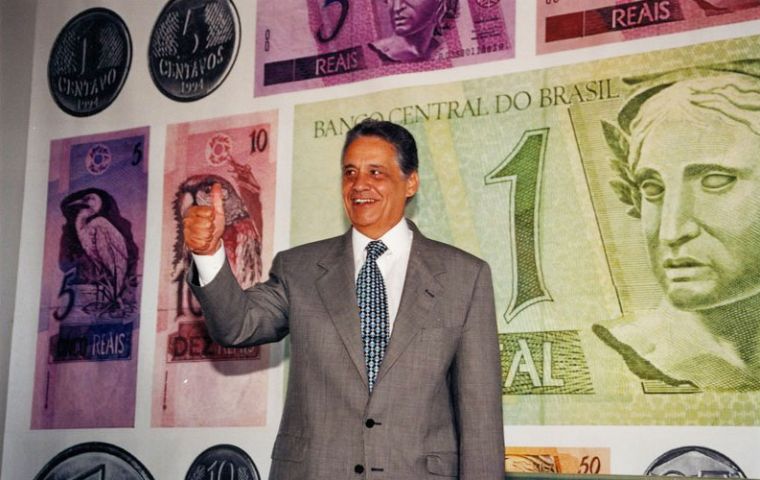MercoPress. South Atlantic News Agency
Two decades of the Real, the currency that helped Brazil trust financial stability
 The Real was implemented when former president Fernando Cardoso was Finance minister of the Itamar Franco administration
The Real was implemented when former president Fernando Cardoso was Finance minister of the Itamar Franco administration Twenty years ago, first July 1994, after decades of financial turmoil, Brazil introduced its current currency, the Real, marking a turning point in the country's fight against hyperinflation.
Many Brazilians still have painful memories of the period in the late 1980s and early 1990s, when people rushed to the supermarkets as soon as they received their salaries, because prices could increase rapidly the following day.
Once a month, families would embark on a shopping expedition worthy of Christmas Eve, and in many homes, large fridges were kept to stock up on food. And minutes after an increase in petrol prices was announced, cars crowded into filling stations, creating huge snaking queues.
As inflation rose to reach more than 2,000% a year (in 1993), life became totally unpredictable. Planning holidays, weddings, or any major event became almost impossible.
Not only because it was difficult to anticipate prices, but also because unorthodox economic plans constantly imposed new currencies and dramatic changes in people's lives.
The most radical of them, the Collor Plan, froze all bank accounts with a balance in excess of 1,000 US dollars in 1991.
“Brazilians who had sold a house, and were about to buy another one, could not go ahead with their purchase,” recalls Ione Amorim, an economist at the Brazilian Consumer Defence Institute (Idec).
It is not difficult, then, to understand why the 20th anniversary of the current Brazilian currency, the Real, is being widely celebrated in South America's largest country.
The Real was launched on 1 July 1994 - after a decade in which the country's currency had changed five times - and was a turning point in the fight against inflation.
The president at the time was Itamar Franco, who followed on the removal by impeachment of Collor de Melo. But the great architect of the new currency system was Fernando Henrique Cardoso, then Finance minister. On the success of the new currency he was to become president on January 1995 for two consecutive terms until January 2003.
“Brazilians suddenly became capable of making plans for the future, instead of having to live in the here and now,” explains Clemens Nunes, of the Getulio Vargas Foundation.
By 1995, the rate of inflation had already fallen to 22% and in the following year it had gone into single figures.
“At that time, most Brazilians were surprised when results came out much better than people thought,” says Persio Arida, one of the architects of the plan which introduced the new currency - known as the Real Plan.
“The Real was a watershed for Brazil's economy, putting an end to four decades of escalating prices,” agrees economist Marcelo Moura, a professor at Insper Business School.
According to economists, one of the reasons behind the success of the Real Plan was its transparency. “All its measures were pre-announced months before they were implemented, to calm expectations,” explains Mr Moura.
The first step of the plan was to create a virtual currency, the real unit of value, or URV, of which was roughly set at a par to the US dollar.
All contracts and prices were gradually converted to this new accounting unit, whose value in the old currency - the Cruzeiro Real - was readjusted daily.
Four months later, the Real was launched, with the same value as the URV.
“But this was only the monetary strategy underpinning the plan,” says Brazilian economist Carlos Braga, professor at the IMD business school in Switzerland.
“It was followed by a series of structural reforms, such as new laws imposing fiscal discipline.”
“As inflation tends to hit the poor hardest, it was also this process that created the basis for the striking poverty reduction which the country experienced during the 2000s,” says Mr Nunes.
“Hyperinflation is no longer a threat, but we still have chronic high inflation, which is causing a lot of damage,” says Rubens Ricupero, who was Brazil's finance minister during the Real Plan.
“Several unions have taken to the streets this year to ask for wage increases, partly because they are concerned about inflation.”




Top Comments
Disclaimer & comment rules-

-

-

Read all commentshey FidoDido !!
Jul 02nd, 2014 - 04:44 pm 0where are you away !?
do you remember that i had said before here ,the Brasil Economy can never grow at hight rates ! ( not reason from the Real value )........
what happened !!!!!
by the way , my regards to your Brasilian girl friend.
keep secret please i know who will be the champion of Worlf Cup !
what a eccentric game.!!!!
Wolf cup? Argentina will lose that, probabably on penalties which they will blame on the opposing team
Jul 02nd, 2014 - 10:05 pm 0I can't see the Real making it to a 21st birthday with The Liar Mantega in charge of the finances!
Jul 02nd, 2014 - 10:34 pm 0Commenting for this story is now closed.
If you have a Facebook account, become a fan and comment on our Facebook Page!